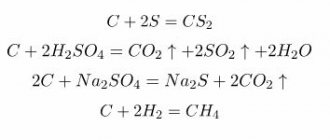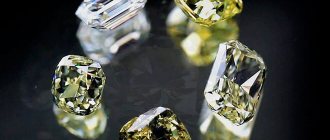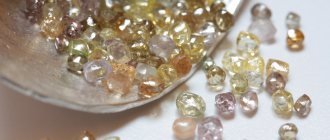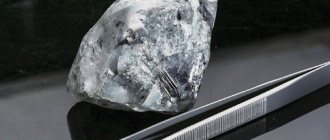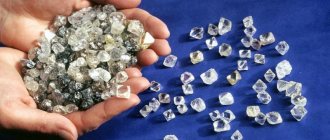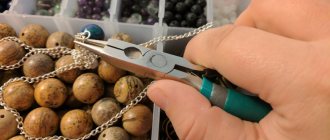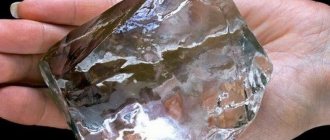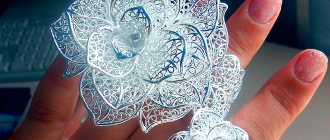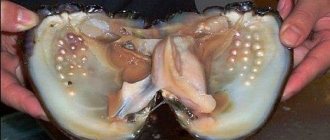Hello, our dear readers! Have you ever wondered what diamond and graphite might have in common? It would seem that a diamond is what expensive jewelry is made from, pleasing the eye of even the most refined taste. Hard, tough and virtually indestructible. And graphite, the main element for making pencils, is very fragile and breaks easily. Remember how often your stylus broke?
However, both minerals are related to each other. Moreover, recreating special conditions makes it possible to carry out the process of transformation from graphite to diamond, and vice versa.
Reading the article will allow you to find out what properties the minerals presented in the article have, how they appeared on Earth in the first place, and where you need to go in order to mine diamonds. Or, if you’re less lucky, graphite, and also, is it possible to make diamonds and graphite at home?
We wish you pleasant reading!
The concept of allotropy
The concept of “Allotropy” has ancient Greek roots: αλλος - other, τροπος - property. Allotropy is the existence of two or more simple substances of the same chemical element. The concept of allotropy was introduced into science by J. Berzelius in 1841 to designate different forms of existence of elements.
The phenomenon of allotropy implies the possibility of creating a certain amount of different substances from the same element. For example, oxygen and ozone contain only oxygen in their composition. The question of how this is even possible has interested many people for a long period of time. Today, scientists can easily explain all the features of this process.
Not all elements are capable of forming several different simple substances. This ability directly depends on the structure of the molecules. Most often, this phenomenon is observed in elements that have variable oxidation states.
This applies to groups such as:
- non-metals;
- semimetals;
- noble gases;
- halogens.
The causes of allotropy can be of several types. The most likely of them, scientists include the following factors:
- Different numbers of atoms required to form one molecule.
- A different order of conjugation of atoms into one molecule.
- Parallels between electron spins.
- A type of crystal lattice.
In order to clearly understand how the phenomenon of allotropy can exist, it is necessary to consider several of the most remarkable examples that are widely found in nature.
Examples of allotropy:
When metals are heated during the transformation process, heat is absorbed, and the change in lattice structure occurs at the same temperature. Many metals are subject to allotropic modifications, for example, titanium, iron, tin, etc. When heated to +1390 ºC, iron is characterized by a face-centered lattice. An increase in temperature to +1540 ºС leads to a restructuring to a centered cubic structure.
Concept and main characteristics of minerals
Diamond is a transparent crystal that has no color and has high light refraction characteristics. The following main properties of the mineral are distinguished:
Nature generates both diamonds in certain shapes and in several crystalline forms, which is due to its internal structure. Pronounced crystals have the shape of a cube or tetrahedron with flat edges. Sometimes the edges appear raised due to the presence of numerous growths and transformations invisible to the eye.
Although many consider diamond to be the strongest material in the world, science knows a substance that is more than 11% stronger than diamond - “hyperdiamond.”
Graphite is a gray-black crystalline substance with a metallic luster. In composition, graphite has a layered structure; its crystals consist of small thin plates. This is a very brittle mineral, resembling steel or cast iron in appearance. Graphite has a low heat capacity but a high melting point. In addition, this mineral:
Graphite feels greasy to the touch and leaves marks when passed over paper. This occurs because the atoms of the crystal lattice are weakly bonded.
Allotropic modifications of carbon
Allotropic modifications of carbon differ most radically from each other in their properties, from soft to hard, etc.
Discovery history:
Carbon in the form of coal, soot and soot has been known to man since time immemorial; about 100 thousand years ago, when our ancestors mastered fire. Probably, very early people became acquainted with allotropic changes in carbon - diamond and graphite, as well as fossil coal. It is not surprising that the combustion of carbon-containing substances was one of the first chemical processes to interest man.
The element was fire, the phenomenon accompanying combustion; In ancient teachings about the elements, fire usually appears as one of the elements. At the turn of the XVII-XVIII centuries. The phlogiston theory arose, put forward by Becher and Stahl. This theory recognized the presence in each combustible body of a special elementary substance - a weightless fluid-phlogiston, which evaporates during the combustion process.
Since when a large amount of coal is burned, only a little ash remains, phlogistics believed that coal was almost pure phlogiston. This is what explained, in particular, the “phlogisticating” effect of coal—its ability to restore metals from “limes” and ores. Later phlogistics, Reaumur, Bergman and others, already began to understand that coal is an elementary substance. However, “clean coal” was first recognized as such by Lavoisier, who studied the process of combustion of coal and other substances in air and oxygen.
In the book “Method of Chemical Nomenclature” by Guiton de Morveau, Lavoisier and Fourcroix (1787), the name “carbon” appeared instead of the French “pure coal”. Under the same name, carbon appears in the “Table of Simple Bodies” in Lavoisier’s “Elementary Textbook of Chemistry.” In 1791, the English chemist Tennant was the first to obtain free carbon; he passed phosphorus vapor over calcined chalk, resulting in the formation of calcium phosphate and carbon. It has been known for a long time that diamond burns without leaving a residue when heated strongly.
Back in 1751, the French king Francis I agreed to provide diamond and ruby for burning experiments. It turned out that only diamond burns, and ruby (aluminum oxide with an admixture of chromium) can withstand prolonged heating at the focus of the ignition lens without damage. Lavoisier carried out a new experiment on burning diamonds using a large incendiary machine and came to the conclusion that diamond is crystalline carbon.
The second allotrope of carbon - graphite in the alchemical period was considered a modified lead luster and was called plumbago; It was only in 1740 that Pott discovered the absence of any lead impurity in graphite. Scheele studied graphite (1779) and, being a phlogistician, considered it a special kind of sulfur body, a special mineral coal containing bound “aerial acid” (CO2) and a large amount of phlogiston. Twenty years later, Guiton de Morveau turned diamond into graphite and then into carbonic acid by careful heating.
The international name Carboneum comes from the Latin carbo (coal). This word is of very ancient origin. It is compared with cremare - to burn; root car, cal, Russian gar, gal and gol, Sanskrit cra means to boil, cook. The word “carbo” is also associated with the names of carbon in other European languages (carbon, charbone, etc.). The German Kohlenstoff comes from Kohle - coal.
Old Russian ugorati, or ugarati (to burn, scorch) has the root gar, or mountains, with a possible transition to gol; coal in Old Russian yugal, or coal, of the same origin. The word diamond comes from the ancient Greek - indestructible, unyielding, hard, and graphite from the Greek - I write. At the beginning of the 19th century. The old word coal in Russian chemical literature was sometimes replaced by the word “carbonate” (Shere, 1807; Severgin, 1815); Since 1824, Soloviev introduced the name carbon.
Comparison
The phenomenon in which substances have different properties, but are formed by a common chemical element, is called allotropy. However, in nature, perhaps, there are no longer such completely different allotropic forms of the same element. What explains the difference between diamond and graphite?
The decisive role here is played by the characteristics of the crystal structure of each substance. Let's talk about diamond. The bond between its atoms is incredibly strong. This is due to the way they are located relative to each other. Adjacent atomic cells of a substance have a cubic shape. Particles are located in the corners of cells, on their edges and inside them. This type of structure is called tetrahedral.
Diamond cell
This geometry of atoms ensures their most dense organization, due to which the diamond becomes hard and resistant to deformation. At the same time, it is a fragile substance that can crack under impact. The structure also determines the high thermal conductivity of diamond and the ability of its crystals to refract light.
Graphite has a different structure. At the atomic level, it consists of layers located in different planes. Each layer is made up of hexagons adjacent to each other, like a honeycomb. The bond between the atoms that are the vertices of the hexagons is strong only within each layer. And atoms located in different layers are practically independent of each other.
Graphite structure
Pencil marks are easily removable layers of graphite. Due to its structural features, the substance absorbs light, taking on a rather inconspicuous appearance (but with a metallic sheen), and is electrically conductive.
The inherent properties of minerals determine their suitability in a particular area. What is the difference between diamond and graphite regarding their applications? A brilliant diamond is ideal for jewelry production. And the hardness of this material allows it to be used to make high-quality glass cutters, super-strong drills and other popular products.
Graphite rods play the role of electrodes during many processes. Crushed graphite is part of mineral paints and is used as a lubricant. And from a mixture of this substance and clay, special containers for melting metals are produced.
This is interesting: What are whiskey stones and why are they needed: subtleties of application and selection
Diamond
Carbon has many allotropic modifications. The main ones are graphite, diamond, carbine .
They differ from each other in physical, chemical properties, and crystal lattice structure. The hardest modification, diamond, is used for the manufacture of industrial tools. According to modern theoretical concepts, nothing in the world can be harder than diamond - such is its crystal lattice. We can say that diamond is the hardest mineral in the world. Diamond melts at high temperatures, from 3700 to 4 thousand degrees. But even earlier, at 850 degrees, it begins to burn, and without air access, when it reaches half the melting temperature, it turns into graphite.
Mining history
Diamonds were not always precious stones that had value and a scale of value. In nature, this pebble is unattractive - a simple rough piece of glass. It is the cut that gives it its value. Everything changed in the 19th century, when diamond seekers settled on the farm of the de Beers brothers in South Africa near the modern city of Kimberley. There were a lot of stones on these lands. Their real industrial production became associated with the name of Cecil Rhodes.
Cecil Rhodes became a monopolist in the diamond market, which was facilitated by the Rothschilds, and diamonds became a consumer product available not only to kings. De Beers' monopoly position was shaken only in the middle of the 20th century thanks to antitrust laws in the USA and the beginning of mass production in countries where there were no opportunities to capture the market in principle - for example, in the USSR. There are several ways to cut diamonds, in which they best demonstrate their properties of color play. The original shape of the stone also plays a role, since the cutter tries to reduce its losses to a minimum.
The most common diamond shapes are:
- round, 57 edges;
- oval;
- "pear";
- "marquise";
- radiant;
- square;
- "princess".
Diamond Structure:
One carbon atom is surrounded by four more atoms in the form of a tetrahedral triangle or pyramid. Each atom is the same distance from each other. The bonds between atoms are very strong, which is why diamond is so hard and durable. Another property of diamond is that it can conduct light, unlike graphite.
How to distinguish a diamond from a fake
Glass is most often used to create artificial samples. Graphite requires more investment and time, and also does not differ in appearance from the real sample. Natural stone must meet the following criteria:
- Defects. Even the purest diamond with an ideal cut should have minimal flaws (small cracks, roughness). An artificial analogue most often has an ideal shape without any flaws.
- Transparency. Although diamond is highly pure, it is impossible to see clear outlines of objects through it. Otherwise, the product is a fake glass.
- Shine. The presence of a cut enhances the initial degree of light refraction. A real mineral should sparkle, and very brightly.
- Fogging. If a sample reacts in this way to high humidity, then it is artificial.
- Strength. Natural material is extremely difficult to damage, so you can safely try to scratch its surface. If traces remain on it, this indicates a fake.
- The influence of heat. The decoration should not heat up quickly. If within a short period of time after contact with the human body it becomes warm, then the diamonds are not real.
ARTIFICIAL DIAMOND
Such an expensive product is often issued with a special certificate, which serves as proof of its origin. Also, the diamond should not shine in different colors of the rainbow - this is a sign of low quality (presence of impurities) or a fake. The shine should be exclusively of one shade (depending on the color of the stone, most often gray).
Graphite
Graphite is a mineral from the class of native elements, one of the allotropic modifications of carbon. The structure is layered. The layers of the crystal lattice can be differently positioned relative to each other, forming a number of polytypes, with symmetry from hexagonal system (dihexagonal-dipyramidal) to trigonal (ditrigonal-scalenohedral).
The layers are slightly wavy, almost flat, and consist of hexagonal layers of carbon atoms.
Mining history:
In the 60s of the 16th century in England. Local shepherds, who found deposits of a strange black-shiny material, at first mistook it for lead, but, realizing that they couldn’t cast bullets from it, they began to break off pieces of black stone and mark their sheep with it. The new material soon attracted the attention of artists and merchants, who quickly established trade in thin plates and pieces of graphite on the English streets. Of course, it was very inconvenient to use - your hands got dirty! I had to wrap the graphite with rope, paper, or even simply press it between boards. This is how the first pencils in a wooden case appeared.
Graphite structure:
Physical properties in graphite vary greatly in directions - perpendicular and parallel to the layers of carbon atoms.
When heated without air access, graphite does not undergo any changes up to 3700°C. At the specified temperature, it sublimes without melting.
Artificial graphite is produced from the best grades of coal at 3000°C in electric furnaces without air access.
Graphite is thermodynamically stable over a wide range of temperatures and pressures, so it is accepted as the standard state of carbon. The density of graphite is 2.265 g/cm3.
There are two known forms of graphite: alpha graphite (has a hexagonal structure and crystal lattice) and beta graphite (has a rhombohedral structure and crystal lattice). In α-graphite, half of the atoms of each layer are located above and below the centers of the hexagon, and in β-graphite, every fourth layer repeats the first.
Alpha graphite can be converted to beta form by mechanical processing. The beta form transforms into the alpha form when graphite is heated above 1300 °C.
Definition
Diamond is a mineral based on carbon. It is characterized by metastability, that is, the ability to exist in an unchanged form under normal conditions for an indefinitely long time. Placing diamond in specific conditions, for example in a vacuum at an elevated temperature, leads to its transition to graphite.
Diamond
Graphite is a mineral that acts as a modification of carbon. During friction, scales are separated from the total mass of the substance. The most famous use of graphite is making pencil leads from it.
Graphite
Fullerene
Fullerene , buckyball, or buckyball is a molecular compound that belongs to the class of allotropic forms of carbon and is a convex closed polyhedron composed of an even number of three coordinated carbon atoms.
The unique structure of fullerenes determines their unique physical and chemical properties. In combination with other substances, they make it possible to obtain materials with fundamentally new properties. Mining history:
The discovery of the fullerene resulted from experiments by Smalley and Croteau with an instrument that Smalley had invented to study molecules and atomic clusters. Kroteau was interested in Smalley's proposed laser evaporation technique. With its help, he intended to test his theory about the behavior of carbon in interstellar space. Croteau believed that carbon-rich red giants were capable of emitting complex carbon compounds that could be detected by radio telescopes.
Fullerene structure:
Atom bond Fullerene is a new allotropic form of carbon. Fullerene molecules consist of 60.70 atoms forming a sphere. Crystalline fullerenes are semiconductors. The variety of physicochemical and structural properties of compounds based on fullerenes allows us to talk about the chemistry of fullerenes as a new promising direction in organic chemistry.
Carbon atoms are located at the vertices of regular hexagons and pentagons that make up the surface of a sphere or ellipsoid. The most symmetrical and most fully studied member of the fullerene family is fullerene (C60), in which the carbon atoms form a truncated icosahedron consisting of 20 hexagons and 12 pentagons and resembling a soccer ball.
The next most common is the C70 fullerene, which differs from the C60 fullerene by the insertion of a belt of 10 carbon atoms into the equatorial region of C60, as a result of which the C70 molecule is elongated and resembles a rugby ball in shape. The so-called higher fullerenes, containing a larger number of carbon atoms (up to 400), are formed in much smaller quantities and often have a rather complex isomeric composition. Among the most studied higher fullerenes are Cn, n=74, 76, 78, 80, 82 and 84.
Physical properties
Physical properties. Carbon exists in a variety of allotropes with very diverse physical properties. The variety of modifications is due to the ability of carbon to form chemical bonds of different types.
Therefore, different modifications exhibit very different physical properties: a very hard substance, a soft substance that conducts electric current, and many others.
Diamond:
Phys. properties. Diamond and graphite differ sharply in physical properties. Properties. Diamonds are transparent crystals, very hard. Hardness is explained by the structure of its crystal lattice. Graphite is a soft dark gray substance with a Me shine.
Graphite:
Physical properties of graphite. – a soft black substance made of easily exfoliated crystals, – conducts electric current, – high-purity graphite is used in nuclear reactors as a neutron moderator. - the melting point at elevated pressure is 3527° C. - At normal pressure, graphite sublimates at 3780° C.
Fullerene:
Physical properties of fullerene Condensed systems consisting of fullerene molecules are called fullerites. The most studied system of this kind is the C60 crystal, less so is the system of crystalline C70. Studies of crystals of higher fullerenes are hampered by the complexity of their preparation.
Similarities and mutual transformations of diamond and graphite
Soft gray graphite and hard transparent diamond have a common base - carbon, i.e. they consist of the same substance. This gave scientists the idea of trying to transform graphite into diamond.
You can get a diamond from graphite in the laboratory or at home. In the first case, the following conditions are needed:
- gas environment (methane);
- pressure more than 50 thousand atmospheres;
- temperature above 1200 °C;
- presence of catalysts (platinum, nickel, iron).
For home experimenters, there are 2 ways. The first one will need:
- current source;
- graphite;
- cold water or liquid nitrogen;
- the wire.
The wire is tied to graphite and lowered into the container. After cooling in a freezer or using liquid nitrogen, current is passed through the resulting wire structure. This contributes to the restructuring of the crystal lattice, rapid transformation into a gem.
The second method involves the appearance of a diamond from a mixture of salt, graphite and distilled water. The thread is lowered into a jar with the prepared solution, and a crystal gradually grows on it.
Graphite can be obtained from a crystal by heating it from 1000 °C; at temperatures from 1750 °C the process occurs quickly.
Also see the reverse method of obtaining graphite from artificial diamonds:
Chemical properties
Diamond:
At ordinary temperatures, carbon is inactive. It can be both a reducing agent and an oxidizing agent. As a reducing agent: Burns in air.
Graphite:
Chemical properties. It forms inclusion compounds with many substances (alkali metals, salts). Reacts at high temperatures with air, burning to carbon dioxide.
Fullerene:
Reduction, nucleophilic addition, cycloaddition, regiochemical multiple addition, halogenation, modification of fullerenes, cluster hydrogenation, addition of radicals, formation of complexes, transition metal oxidation and reactions with electrophilic reagents.
Practical part
Application of allotropic modifications of carbon. Diamond - in industry: it is used to make knives, drills, cutters; in jewelry making. The future is the development of microelectronics on diamond substrates. Graphite – for the manufacture of melting crucibles, electrodes; plastic filler; neutron moderator in nuclear reactors; component of the composition for the manufacture of leads for black graphite pencils (mixed with kaolin) Fullerene - in batteries and electric batteries (fullerene additives); pharmacology (HIV treatment); Solar cells; fire retardant paints.
New allotropic modification:
On August 15, 2021, a team of scientists from IBM and the University of Oxford published a paper presenting data on the successful synthesis of the cyclo[18]carbon molecule. Previously, the existence of cyclocarbons was considered only hypothetical, but now C18 is a representative of a new allotropic modification of carbon.
C18 was obtained by removing carbon monoxide from the C24O6 molecule by the principle of atomic force microscopy on a two-layer sodium chloride surface at a temperature of 5°K (-268.15°C). According to scientists, cyclocarbons may prove useful in computer technology as an extremely energy-efficient computer logic device. In addition, the creation of C18 opens the way for the synthesis of other carbon allotropes, but for now, an in-depth study of the properties of the new molecule remains.
Conclusion
Carbon is the substance with the largest number of allotropic modifications. The project considers allotropic modifications of diamond, graphite, and fullerene. Carbon and its allotropic modifications are of great practical importance in human life and industry.
Most of the things in our lives we received thanks to allotropic modifications, for example, a drill, black graphite pencils and batteries.
Thanks to this project, we learned how and who helped us improve our lives.
Based on all the work done, we can draw the following conclusions:
- Firstly, I studied and examined in detail the types of allotropy.
- Secondly, I found out who discovered allotropy and where it is used.
- Thirdly, I made a stand that clearly shows what allotropy looks like.
Scope of application
Diamond and graphite are used much more widely than it might seem at first glance. Diamonds have found their application in the following areas:
The percentage of diamond use looks like this:
- Tools, machine parts – 60%.
- Framing of grinding wheels -10%.
- Wire recycling - 10%.
- Well drilling – 10%.
- Jewelry, small parts – 10%.
As for graphite, it is practically not used in its pure form, but is subject to pre-processing, although graphite of different qualities is used in different areas. The highest quality graphite is used for stationery pencils. It is most widely used in foundries, providing a smooth surface to various forms of steel. Almost unprocessed graphite is used here.
The electrocoal industry, along with natural graphite, uses artificially created graphite, which is also widely used due to its special purity and consistency of composition. Electrical conductivity has made graphite a material for electrodes in electrical devices. In metallurgy it is used as a lubricant.
Diamond and graphite are identical in composition, but unique in their own way. The benefits of graphite for various industries are much higher than diamond.
Diamond, designed to delight with its beauty, is invaluable to the economy, bringing huge profits from its use in the jewelry industry.
Hard diamond that plays in the light and opaque, easily peeled graphite can be figuratively called siblings. After all, in the chemical composition of both, there is only one element - carbon. Let's find out why, having a common origin, these minerals are so different from each other and how diamond differs from graphite.
